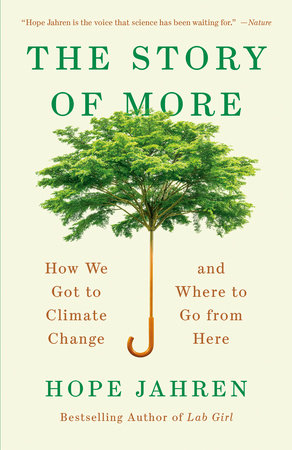The Story of More: How We Got to Climate Change and Where to Go from Here
- By Hope Jahren
- Vintage
- 224 pp.
- Reviewed by Gretchen Lida
- April 1, 2020
A perfect, pocket-size primer on environmental problems and solutions.

We might combat climate crises by leaving copies of Hope Jahren’s The Story of More: How We Got to Climate Change and Where to Go from Here in strategic public places: on those display racks by the drink coolers in corner stores; near checkout counters at Tractor Supply; in every DMV line in America. If there’s one book all of us should read about the state of the environment, it’s this one.
Sure, that might seem a little overzealous. One book isn’t going to solve the slow-motion catastrophe of a warming planet. It will, however, help readers understand the problem without making them run to the bunkers of fear, shame, denial, and tribalism.
Books like David Wallace-Wells’ The Uninhabitable Earth, Elizabeth Kolbert’s Field Notes from a Catastrophe, and many other climate-change works are important and well written, but they often leave readers paralyzed.
How does Jahren avoid this?
She pulls off the feat of presenting climate change without emotional baggage through accessibility and humor. Jahren’s funny, lyrical memoir, Lab Girl, about her life as a paleobiologist, was a national bestseller. (The vivid scene where her lab partner, Bill, cuts his hair and then stashes it in a tree trunk lingers long after the book is closed.) This same quirky clarity animates The Story of More.
Like Jane Austen, Jahren pokes fun at the absolutists, the purists, and the overly serious. She finds the piety of vegans tiresome, Americans’ obsession with cars irritating. A native of Minnesota and a globe-trekking scientist, she straddles the virtues and vices of the rural and the urban. The tidbits of personal history add a layer of vulnerability and give readers a main character who complements the science of the book.
Jahren, born in 1969, uses dates along her own timeline as guideposts. The 1970s have often been cited as the run-up point in humanity’s catastrophic treatment of Mother Nature. Environmental baselines from that decade, therefore, serve as comparisons for rising sea levels and energy consumption (both of which have grown exponentially).
The Story of More is written in short, easy-to-read, well-researched chunks. Each chapter covers a different aspect of climate change, from the growth of high fructose corn syrup production to the increase in electricity consumption. This delineation of factors creates a feeling of responsibility across sectors and a sense that this big mess is both cultural and systemic.
Jahren’s not just a scientist with a sociologist’s bent. She is versed in history and art, too, and offers readers wisdom and gravitas. With The Story of More, she calls out for a better understanding of our collective origin and rootedness: Who are we if we forget our links to the earth?
She quotes Shelley and Shackleton. In the section called “Raising Meat,” Animal scientist Temple Grandin appears on one page, and The Jungle’s Upton Sinclair on the next. Not only is this quite the writerly flex, but it also reminds us no matter our profession, we’re all part of climate change.
Along with being a gifted writer and a world-renowned scientist, Jahren has been teaching courses on climate change since 2009. While she notes that she initially taught the subject grudgingly, she is obviously good at it. The prose in The Story of More has the steady hand of a good teacher:
“My own goal is to inform you, not to scare you, because teaching has taught me to know and respect the difference. I’ve found that fear makes us turn away from an issue, whereas information draws us in.”
Jahren’s pedagogy is like the concept of a Growth Mindset — the idea that mistakes and new knowledge aren’t threatening. Rather, they’re concepts to bounce off and learn from. The word “growth” also echoes the “more” in Jahren’s title. The story of more stuff: more fuel consumption, more waste, more carbon, all of which lead to the gluttonous peril we now face.
But there’s an alternative to “more.” In the last section of the book, titled “the Story of Less,” Jahren implores us to assess what we value most. As to the question of more, she argues we could aim for more equity, more knowledge, and more habitable years on the planet.
Along those lines, it wouldn’t hurt to have more books by Hope Jahren, too.
Gretchen Lida is an essayist and an equestrian. Her work has appeared in the Washington Post, the Rumpus, the Los Angeles Review of Books, and many other publications. She is a contributing writer to Book Riot, Horse Network, and the Independent, and is working on her first book. She lives in Chicago and is still a Colorado native.

